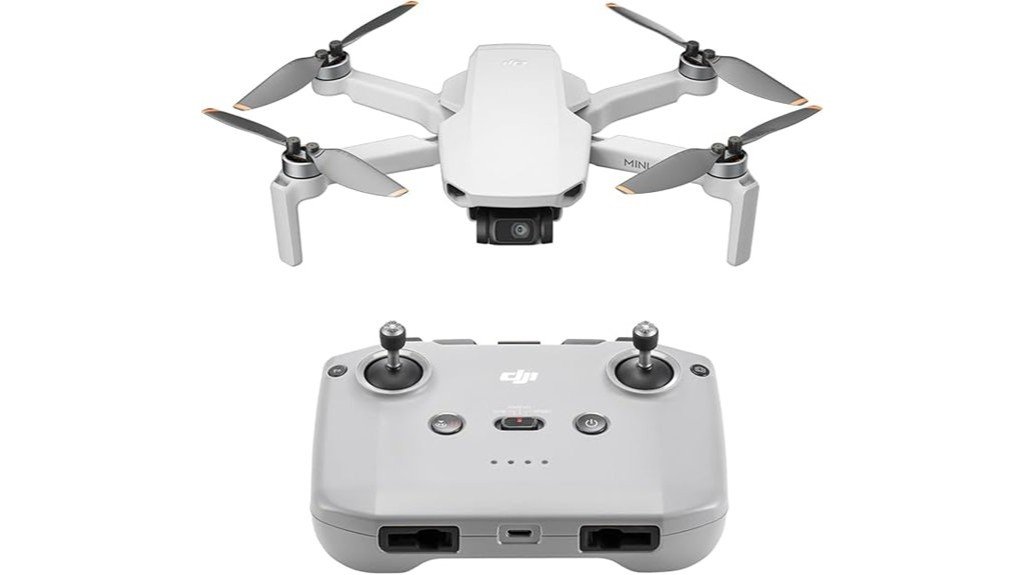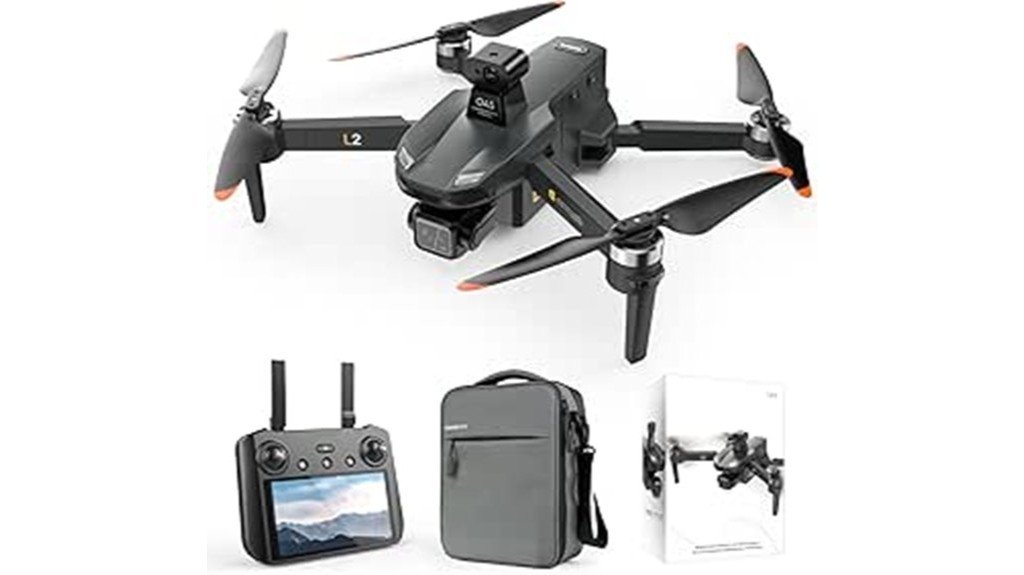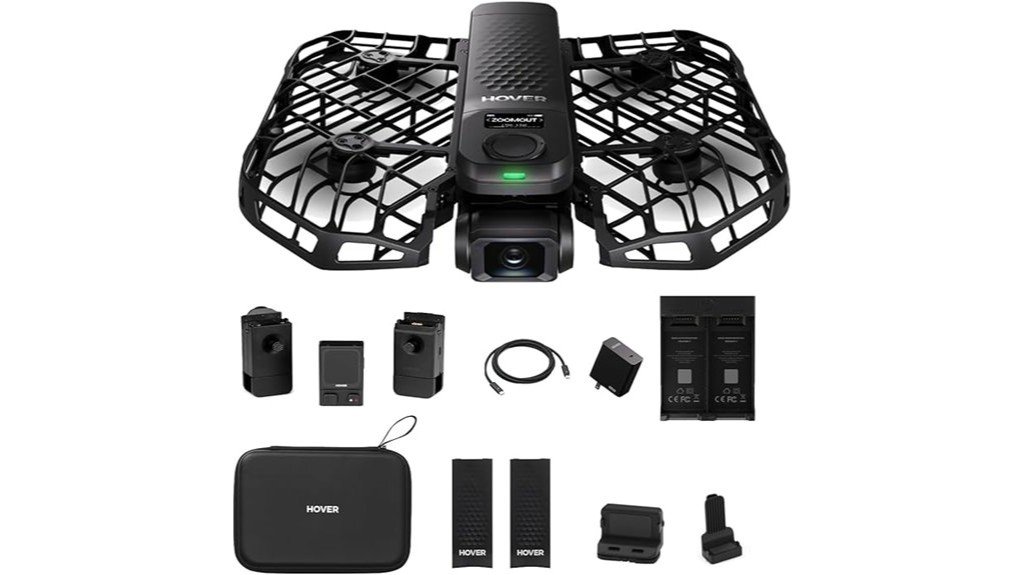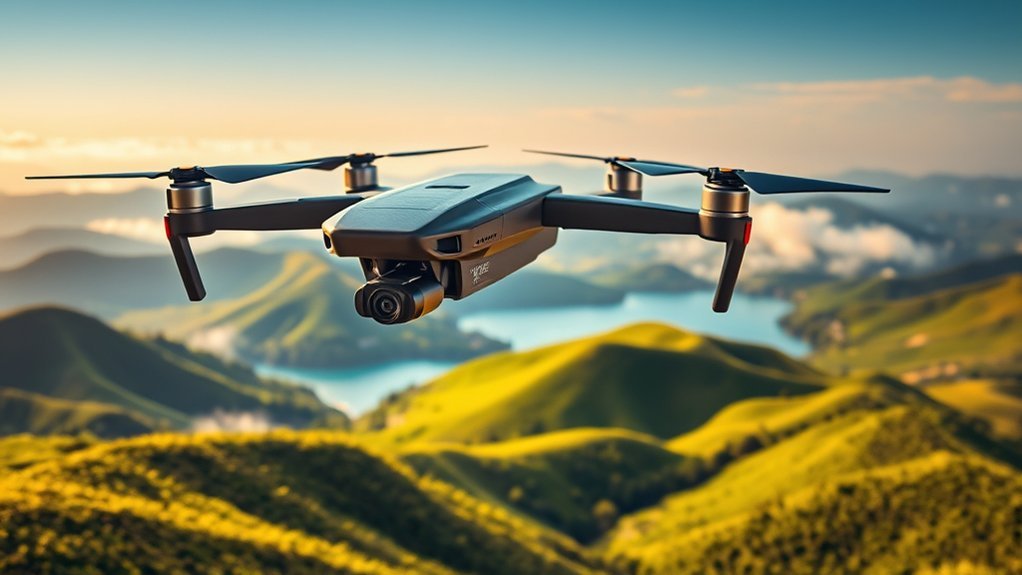In a world where filmmaking technology is either cutting-edge or outdated, finding the right drone can make all the difference. With so many options available, how do you choose the one that elevates your cinematic vision? From lightweight designs to advanced stabilization features, the best drones of 2025 offer something for every filmmaker. Let’s explore the top contenders and what sets them apart in the ever-evolving landscape of aerial cinematography.
DJI Mini Drone with 4K UHD Camera

If you’re looking for a lightweight drone that won’t require FAA registration, the DJI Mini Drone with its 4K UHD camera is ideal for enthusiasts and filmmakers alike. Weighing under 249 grams, it’s easy to carry and fly without hassle. With a 3-axis gimbal, you’ll capture cinematic-quality footage, even in challenging lighting conditions. Enjoy up to 31 minutes of flight time per battery, and feel secure with its GPS Return to Home feature. Plus, with intelligent flight modes like QuickShots, you can create stunning videos effortlessly. This drone’s user-friendly design makes it perfect for both beginners and seasoned pilots.
Best For: The DJI Mini Drone with 4K UHD camera is best for both beginner and experienced drone enthusiasts looking for a lightweight, easy-to-use aerial photography solution.
Pros:
- Lightweight design (under 249 g) allows for easy transport and no FAA registration required.
- High-quality footage with a 4K UHD camera and 3-axis gimbal for stabilization.
- User-friendly features such as one-tap takeoff/landing and GPS Return to Home enhance the flying experience.
Cons:
- Limited flight time of 31 minutes per battery may require additional batteries for extended use.
- Wind resistance is capped at 38kph, which may limit flying in breezy conditions.
- No advanced obstacle avoidance features, which may pose challenges for inexperienced pilots in complex environments.
Upgraded Pro Drones with Camera for Adults

For adults looking to elevate their filmmaking skills, upgraded pro drones equipped with high-quality cameras offer exceptional features that stand out. With 4K UHD photo and video capture, you’ll create stunning visuals. Enjoy long-distance capabilities of up to 5 miles and a flight time of 84 minutes with dual batteries. The 3-axis gimbal with EIS anti-shake technology keeps your shots steady, while night mode and time-lapse features add versatility. You’ll appreciate the professional remote with GPS, obstacle avoidance, and various flight modes. This drone is perfect for hobbyists and casual users, ensuring reliable performance and stunning results.
Best For: Adults looking to enhance their filmmaking skills with a reliable and high-quality drone equipped for stunning aerial photography and videography.
Pros:
- Exceptional 4K UHD photo and video capture for high-quality visuals.
- Long flight time of 84 minutes with dual batteries and impressive range of up to 5 miles.
- User-friendly features like GPS, obstacle avoidance, and various flight modes enhance the flying experience.
Cons:
- Outdoor calibration is required prior to flight, which may be inconvenient for some users.
- Some customers noted suggestions for app improvements, indicating potential usability issues.
- Weight of 1.29 pounds may be considered bulky for those seeking ultra-lightweight options.
X1 PRO 4K Action Flying Camera Drone

The HOVERAir X1 PRO 4K Action Flying Camera Drone is a game-changer for both novice and seasoned filmmakers looking to elevate their content. With its foldable design and durable aerospace-grade materials, it’s incredibly portable. Capture stunning 4K footage at 60fps using its advanced SmoothCapture 2.0 gimbal for steady shots. The drone offers over 10 automatic flight modes, including Follow and Dolly Track, making it easy to get creative. Plus, its AI tracking keeps your subjects centered during high-speed action. With hands-free operation and an intuitive app, you’ll have everything you need for capturing breathtaking moments effortlessly.
Best For: The HOVERAir X1 PRO 4K Action Flying Camera Drone is best for both beginners and experienced users seeking an easy-to-use, high-quality aerial filming solution.
Pros:
- Excellent 4K video quality with advanced stabilization for smooth footage.
- Versatile flight modes allow for creative filming options and hands-free operation.
- Lightweight and portable design makes it ideal for travel and outdoor activities.
Cons:
- Suggested enhancements include better color profiles and the absence of a physical remote.
- Limited internal storage capacity may require additional SD cards for extended use.
- Some users may prefer a more traditional control method over app-based operation.
Factors to Consider When Choosing a Drone for Movies
When you’re choosing a drone for movies, several key factors will impact your decision. You’ll want to think about camera quality, stability, flight time, and user-friendly controls to capture the best footage possible. Each of these elements plays an essential role in ensuring your aerial shots are stunning and smooth.
Camera Quality Importance
Camera quality is a game-changer in cinematic production, directly influencing the visual impact of your films. Opting for a drone with 4K Ultra HD resolution means you’ll capture four times the detail of standard 1080p, elevating your visual storytelling. Look for drones equipped with larger sensors and higher effective still resolutions, like 48 MP, to enhance image quality, especially in low-light situations. Features such as night mode and time-lapse capabilities open up creative filming possibilities, allowing you to adapt to various lighting conditions. Plus, capturing high frame rates, like 60fps, lets you create stunning slow-motion shots that can add dramatic flair to your scenes. Prioritizing camera quality is essential for achieving professional-grade cinematic results.
Stability and Gimbal Features
Choosing a drone with robust stability and gimbal features can make a significant difference in your filmmaking experience. A 3-axis gimbal is essential for stabilizing footage, ensuring smooth, professional-quality videos no matter how the drone moves or the wind blows. Drones with electronic image stabilization (EIS) further reduce motion blur and vibrations, delivering clearer images, especially during dynamic scenes. Advanced gimbal systems that offer horizon leveling maintain your camera’s orientation, vital for cinematic shots. Additionally, SmoothCapture technology allows precise control of camera angles, making pans and tilts effortless. Finally, stability features like collision detection and obstacle avoidance enhance safety, ensuring uninterrupted shooting in complex environments. Prioritizing these aspects will elevate your drone filmmaking to new heights.
Flight Time Considerations
Flight time plays an essential role in your filmmaking, as it directly impacts how much footage you can capture during a single session. When selecting a drone, look for models that offer longer battery life—around 31 to 42 minutes per battery is ideal. This can greatly reduce downtime and keep your shooting schedule efficient. Consider factors like battery capacity, weight, and energy consumption, as they all affect flight time. Advanced drones often include features like auto-return when battery levels are low, which helps prevent crashes. Additionally, understanding the charging time and having extra batteries on hand can guarantee a smooth production flow, allowing you to focus on capturing stunning visuals without interruptions.
Range and Altitude Capability
When you’re planning to capture stunning aerial shots, understanding a drone’s range and altitude capabilities is crucial. The range determines how far your drone can fly from the controller while maintaining a stable connection, with some models reaching up to 5 miles. Altitude capability is equally important; drones can soar as high as 4,000 meters, providing diverse perspectives for your shots. Wind resistance also plays a role—look for drones that can handle winds up to 38 kilometers per hour to guarantee stable flight during outdoor shoots. These range and altitude features greatly affect the quality of your footage, allowing you to film sweeping landscapes and dynamic scenes in various environments, from bustling cities to serene natural settings.
User-Friendly Controls and Modes
User-friendly controls and intelligent flight modes can make all the difference in your drone filmmaking experience. Features like one-tap takeoff and landing simplify flying, making them perfect for beginners. With intelligent flight modes such as Follow Me and automated QuickShots, you can capture stunning cinematic shots with minimal effort. GPS-enabled functions enhance your filming by ensuring stable hovering and auto-return, so you can focus on your creative vision. Plus, in-app learning resources and guided tutorials help you master both drone operation and cinematic techniques quickly. If you opt for voice command options, you’ll enjoy a more seamless filming experience, allowing you to concentrate on crafting your masterpiece without distraction. Choose wisely to elevate your filmmaking game!
Safety Features and Reliability
Safety features and reliability are essential considerations for any filmmaker looking to capture stunning aerial shots with a drone. Look for drones equipped with 360° obstacle avoidance technology to minimize collision risks. GPS-enabled auto-return capabilities are also vital, as they guarantee the drone returns to its takeoff point if the signal is lost or the battery runs low. Advanced collision detection systems, like rear proximity sensors, can help prevent accidents while tracking. A stable flight system with electronic image stabilization and gimbal support will enhance safety, especially in windy conditions. Finally, review user feedback to gauge a drone’s flight stability and the responsiveness of its safety features in real-world scenarios.
Portability and Durability Factors
Choosing the right drone for capturing movies hinges on its portability and durability, as these factors can make or break your filming experience. Lightweight drones under 249 g are ideal since they’re easier to transport and don’t require FAA registration. Opting for foldable designs allows you to pack your drone conveniently in backpacks or camera bags, perfect for on-the-go shoots. Durability is also essential; look for drones crafted from aerospace-grade materials that can handle rain and rugged terrains. A robust construction enhances reliability over diverse landscapes like snow or water, expanding your shooting possibilities. Ultimately, lightweight, easy-to-control drones facilitate smooth operation, ensuring stable footage without the hassle of heavy equipment.
Frequently Asked Questions
What Is the Average Flight Time for These Drones?
The average flight time for most consumer drones is around 20 to 30 minutes. However, some high-end models can fly up to 40 minutes or more, depending on battery capacity and usage conditions.
Are These Drones Suitable for Beginners?
Absolutely, these drones are suitable for beginners! Don’t you want to explore the skies effortlessly? With user-friendly controls and intuitive features, you’ll quickly gain confidence and capture amazing footage without feeling overwhelmed.
Do the Drones Include Spare Batteries?
Yes, many of these drones come with spare batteries. You’ll appreciate the extra flight time, allowing you to capture more footage without interruptions. Just double-check the specifications to guarantee you get what you need.
Can I Fly These Drones Indoors?
Studies show that over 70% of drone enthusiasts prefer flying indoors. You can fly these drones indoors, but always check your surroundings to avoid obstacles and guarantee safety. Enjoy the indoor experience while capturing stunning footage!
How Do I Maintain My Drone for Optimal Performance?
To maintain your drone for peak performance, regularly clean the propellers, check battery health, update firmware, and inspect for damage. Storing it in a cool, dry place also helps keep it functioning smoothly.

